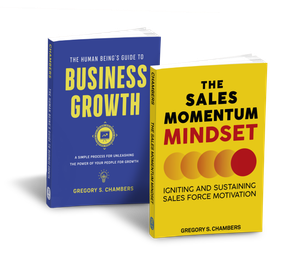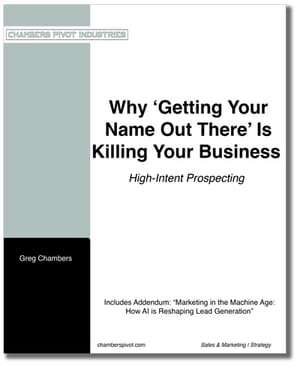Business Growth Newsletter #195: Vision, Default Value Orientation, Peloton

GREG'S RIGHT FIT NEWSLETTER #195
Quick notes to help you grow your business in less time with less effort. . . sometime next week.
In this issue:
- Techniques for FIT
- Being Human
- Random Stuff
Techniques for FIT
- One challenge your people have with prospect meetings is getting (and staying) on track. They chat too much or are too serious. Have them use written agendas and share them to start the meeting. It gives them a nice way to uncover new issues ("before we start...") and get permission to go into overtime ("...we're not done, should we continue?").
- Need your people answering direct pricing questions better? Tell them to use ranges and couch it in language like, "I don't know enough about YOUR exact situation to give a quote, and I hate to even give a range because you'll remember the low end and I'll remember the high. . .BUT, if you were to twist my arm I'd say companies looking for the results you want tend to invest between X and Y." Then move on.
- Tell you team to take notes on objections, this way you can sit and role play with them. Help them address objections with both EQ and IQ. I'm guessing their current answers are heavy on logic, low on emotion. Reverse that.
- How important is your vision of the future to your success? It's the whole thing. As anecdotal evidence, I give you this from "They Call Me Supermensch," Shep Gordon's autobiography: "I sit and smoke a joint and think, Wouldn't it be amazing if. . .? And then I start figuring out how to pull it off." Start with the vision then get to work. Good stuff.
Being Human - Default value orientation ------------------------------------------------------------
“I would never pay that much for a car. Never." (some guy that looks and sounds like my Dad)

Here's a concept to help your business development team. Make sure your customers think like you think they think. Put simply, know your buyer’s decision process, especially their default value orientation. The tendency is to assume your customers make decisions the same way you make decisions, that they share your same value orientation. Invest time confirming that your customers think like you think they think. Learn about their default value orientation. It will save you time in the long run.
I learned this lesson when I worked at a bicycle shop located near a hospital. The shop carried Specialized and Miyata bicycles that ranged from $300 to over $7,500 (it was the early 1990s). For the clear majority of our customers, middle-aged doctors and lawyers, the bicycles that met their needs were in the low $700 range. Better than entry level bikes, but not at the level of the expensive racing bikes. However, like moths to a flame, the
doctors headed straight to the most expensive models. Their default value orientation drew them to handcrafted frames with advanced suspensions that forced the rider into hunched-over positions their paunchy bellies weren’t made for. Why pay for more than you need? I thought. Expensive bikes were made for a single season of hard-core racing and meant to be ridden by a crazy fit 20-year-old pro, not these guys. In my mind, it was the wrong solution, a waste of money.
Overhearing me talk to one of these doctors, the owner pulled me
aside and said, “Greg, they’re not spending your money, they're spending their money.”
(Click to read the full article)
Random Stuff
"I'll be downstairs exercising."
Does anyone else have friends that love their Peloton bikes and send pics of their favorite instructors to you?

Just checking.
If you need to set up a time to visit, follow this link:
https://calendly.com/chamberspivot/





